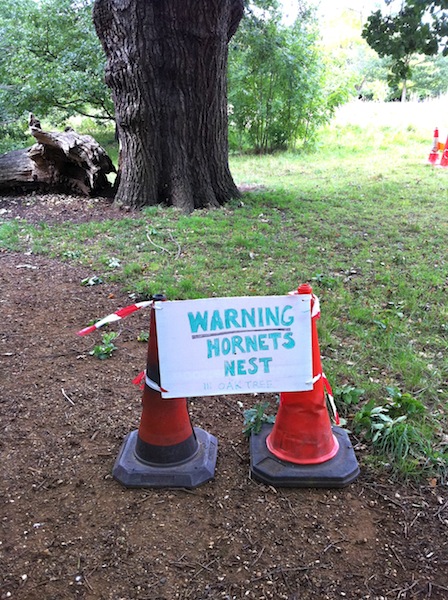It was really a bit late in the year for the best of the wildlife; many of the classic Mediterranean birds — bee-eaters and what have you — were probably already in Africa, and there weren’t many flowers around. Although the oleander everywhere still looked spectacular.

Not that it was a complete bust on the bird front. It was nice to see lots of black redstarts everywhere; I saw a couple of female pied flycatchers, which are also charming little birds; there were crag martins flying around at the Pont du Gard (above); and I saw dipper at a coffee break on the way back. So no absolute show-stoppers, but some nice things.
Also, to stay on-theme with my recent post, I was pleased to see plenty of hornets around. It’s very much wasp time of year, of course: my mother tells me that the wasps ‘come with the plums’. It’s not strictly true, you see wasps all summer, but there are a lot more in late summer/autumn. That’s because (I learnt recently while reading about hornets), a lone queen starts a new nest every year.* Which makes large wasp nests all the more impressive.
The queen then has to build the nest and gather food for the young on her own until there are enough workers around to do the scut work, and she can concentrate on producing eggs. And they build up the nest until in late autumn they produce a load of reproductive individuals — queens and drones — and those fertilised queens who survive the winter set out and start the cycle again in spring. So a single wasp queen may have generated thousands of individuals by the time the plums are ripe. Or hundreds, for the hornets.
Also pleasing was a praying mantis; we don’t get those up here in northern Europe. I think the species was Mantis religiosa, which I guess was the very first of the mantids to be given a Latin name, presumably by Carl Linnæus personally.
Another curiosity with a great Latin name was a tree with what looked like huge red chiles growing on it. It turns out the tree is a relative of the pistachio called terebinth (another great name, incidentally), and the ‘chile’ is a gall formed by an aphid, Baizongia pistaciae. To which I just have to say: baizongia!

And finally on to the Lepidoptera. Above is a pretty little day-flying moth, related to the burnets, called Zygaena fausta. The flower is Virgin’s-bower, Clematis flammula.
And there were loads of good butterflies, which I mainly don’t have photos of. Clouded Yellow, Cleopatra (the Brimstone’s flashier cousin), Southern White Admiral, some kind of amazing iridescent blue which was probably either Adonis Blue or Turquoise Blue, and the curious-looking Nettle-tree Butterfly or European Beak.
And there was this tiny little fellow, the Geranium Bronze, living up to his slightly inaccurate name by sitting on a pelargonium:

The Geranium Bronze is actually an import from South Africa which apparently arrived on imports of pot plants. Notice the teensy little swallowtails! Cute.
But the most spectacular butterflies were two big species. One, the Great Banded Grayling, is hard to do justice to in photographs because it sits with its wings closed, but this blog post shows one displaying itself properly.
And most remarkable was a huge great fast-flying thing which when you see it properly, looks pretty amazing above and maybe even more spectacular below. Yup, it’s one of Europe’s most exotic-looking butterflies, the Two-tailed Pasha or Foxy Emperor. Woo-hoo.
* or to be more strictly accurate: most European species of social wasp start a new nest each year; your local wasps may vary.
